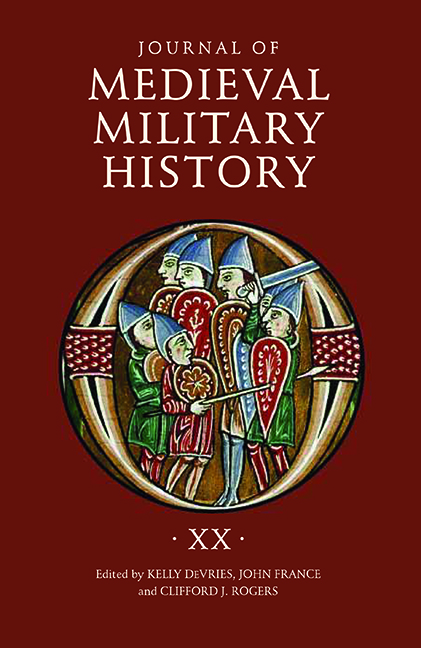Book contents
- Frontmatter
- Contents
- List of Illustrations
- 1 De velitatione bellica and the Georgian Art of War During the Reign of David IV
- 2 The Afterlife of the Medieval Christian Warrior
- 3 More Accurate Than You Think: Re-evaluating Medieval Warfare in Film
- 4 Raising the Medieval Trebuchet: Assembly Method and the Standing of a Half-scale Machine
- 5 Cum Socio Eiusdem: Military Recruitment in the Armies of Edward I Among the Sub-Gentry
- 6 Two Walls of Protection: Queen Elionor of Sicily and Bishop Berenguer de Cruïlles of Gerona During the 1359 Naval Campaigns of The War of the Two Pedros
- 7 The Lancegay and Associated Weapons
- 8 “I intend to give him battle.” Battle-Seeking in a Civil War Context: Toro (1476)
- 9 Discovery of an Early Sixteenth-Century Battle Plan from the Archdiocesan Archive in Ljubljana
- List of Contributors
- Journal of Medieval Military History 1477-545X
6 - Two Walls of Protection: Queen Elionor of Sicily and Bishop Berenguer de Cruïlles of Gerona During the 1359 Naval Campaigns of The War of the Two Pedros
Published online by Cambridge University Press: 07 October 2022
- Frontmatter
- Contents
- List of Illustrations
- 1 De velitatione bellica and the Georgian Art of War During the Reign of David IV
- 2 The Afterlife of the Medieval Christian Warrior
- 3 More Accurate Than You Think: Re-evaluating Medieval Warfare in Film
- 4 Raising the Medieval Trebuchet: Assembly Method and the Standing of a Half-scale Machine
- 5 Cum Socio Eiusdem: Military Recruitment in the Armies of Edward I Among the Sub-Gentry
- 6 Two Walls of Protection: Queen Elionor of Sicily and Bishop Berenguer de Cruïlles of Gerona During the 1359 Naval Campaigns of The War of the Two Pedros
- 7 The Lancegay and Associated Weapons
- 8 “I intend to give him battle.” Battle-Seeking in a Civil War Context: Toro (1476)
- 9 Discovery of an Early Sixteenth-Century Battle Plan from the Archdiocesan Archive in Ljubljana
- List of Contributors
- Journal of Medieval Military History 1477-545X
Summary
This article deals with two unlikely political figures who emerged during the most important phase of the War of the Two Pedros (1356–1366), the sea war of 1359 during which the Castilian king, Pedro I (1350–1366/69), attacked the Valencian, Catalan and Majorcan coasts only to be repelled by the Aragonese sovereign, Pere III (1336–1387). The first of these figures was Pere III's third wife, Elionor of Sicily, who, as one of the only Aragonese queens of that time to receive a formal coronation, was a true political helpmate to her husband. As Governor of Catalonia and royal lieutenant, Elionor took it on herself to arrange for the coastal defense of Catalonia and Valencia while her husband was pursuing his Castilian enemy into Majorcan waters, She raised these military units by enforcing emergency taxes on Catalonia. Elionor was also a strong supporter for her husband's naval campaigns and repeatedly took it on herself to spread the news of these exchanges. The other unlikely figure to emerge during the naval crisis was Bishop Berenguer of Gerona who received authority to gather even larger tax amounts than did the queen when in the same year of 1359 he was elected as the first president of the Catalan Deputació, a permanent parliamentary body of Catalonia which remained in session to fully carry out the directives of Catalonian Corts. In some ways, then, these largely forgotten figures helped the badly pressed Crown of Aragon to stand once again against its much stronger Castilian opponent.
The War at Sea, 1359
Medieval Spain's longest conflict between Christian forces, the War of the Two Pedros (1356–66), was largely fought along the rugged frontiers of Castile and Murcia on the one hand and those of Aragon and Valencia on the other. Military exchanges between the Iberian enemies were normally fought as cabalgadas, cross-border raids that seldom involved more than 3,000 troops, most of them mounted. After almost three years of this kind of asymmetrical warfare, the twenty-five-old Castilian king, Pedro I (r. 1350–66/69), attempted to attack the lucrative Mediterranean waters of Valencia and Catalonia.
- Type
- Chapter
- Information
- Journal of Medieval Military HistoryVolume XX, pp. 125 - 136Publisher: Boydell & BrewerPrint publication year: 2022



